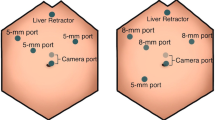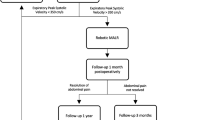Abstract
Although results of surgical treatment will be discussed in Chap. 30, one of the key factors to consider before embarking on open median arcuate ligament (MAL) release is the potential outcomes based on symptoms, patient age, associated comorbidities, and preoperative assessment. Reilly et al. demonstrated that patients with atypical pain patterns, age greater than 60 years old, weight loss less than 20 lbs, and a history of psychiatric disease or alcohol abuse were less likely to improve after MAL release. The patient and surgeon should have a frank discussion regarding the difficulty in predicting postoperative outcomes after MAL release, particularly because of the wide overlap of symptoms of MAL syndrome (MALS) with other gastrointestinal and intra-abdominal pathologies.
Access provided by Autonomous University of Puebla. Download chapter PDF
Similar content being viewed by others
Keywords
- Median arcuate ligament syndrome
- Open median arcuate ligament release
- Ganglion resection
- Percutaneous transluminal angioplasty of chronic mesenteric ischemia
- Celiac compression
Although results of surgical treatment are discussed in Chap. 30, one of the key factors to consider before embarking on open median arcuate ligament (MAL) release is the potential outcomes based on symptoms, patient age, associated comorbidities, and preoperative assessment [1]. Reilly et al. demonstrated that patients with atypical pain patterns, age greater than 60 years old, weight loss less than 20 lbs, and a history of psychiatric disease or alcohol abuse were less likely to improve after MAL release [1]. The patient and surgeon should have a frank discussion regarding the difficulty in predicting postoperative outcomes after MAL release, particularly because of the wide overlap of symptoms of MAL syndrome (MALS) with other gastrointestinal and intra-abdominal pathologies [1].
Open MAL Release
Surgical management, either open or via laparoscopic technique, is nearly always required in order to release the mechanical compression of the fibrous median arcuate band, resect the celiac ganglion, and inspect the celiac artery, often with ultrasound [1–4]. Although endovascular treatment of celiac compression have been reported [5–8], the risk of restenosis or stent compression is high in this generally low-risk, healthy patient group who tolerate open procedures and general anesthesia well.
MAL release is performed through an upper abdominal incision from the xiphoid to several centimeters above the umbilicus. A subcostal incision can be considered depending on the patient’s body habitus. A nasogastric tube is placed after anesthesia to assure identification of the esophagus during mobilization of the MAL. The diaphragm fibers draped over the aorta are divided proximal to the celiac artery. At this point, the celiac ganglion fibers should be visible and can be divided with cautery or ligated. The celiac artery is then skeletonized of all surrounding nerve and muscle fibers (Fig. 28.1a–d).
A 45-year-old woman with celiac compression identified on CTA and a 25-lb weight loss with abdominal and back pain. (a) The crus of the diaphragm (arrow) is dissected and the ganglion fibers isolated with a right-angle clamp. (b) The ganglion fibers are divided with electrocautery. (c) The ganglion fibers retract and are excised along with the diaphragmatic fibers. (d) The origin of the celiac artery is freed of all surrounding tissue (arrow) and assessed by palpation and ultrasound exam
Most authors agree that after the celiac artery is inspected and patency assessed, ideally with palpation, Doppler exam, and ultrasound, a decision is made whether celiac artery reconstruction is indicated. Reilly et al recommend celiac reconstruction for all patients with a visible celiac artery deformity, thrill, or pressure gradient [1]. At our institution, all patients undergo intraoperative ultrasound (Fig. 28.2a–c) after open MAL resection, with ~40 % demonstrating residual celiac stenosis despite adequate MAL release [2]. Depending on the length of the stenotic lesion and the proximity to the aorta, either patch angioplasty (bovine pericardium or polyester graft patch) or aortoceliac bypass is recommended. In our early series, patients also had intraluminal dilation but this technique was abandoned due to less favorable success rates. In addition, because of the elongation of the celiac artery in some cases, primary reanastomoses has also been reported.
After MAL release in a 37-year-old woman, intraoperative duplex identified a fixed stenosis (arrow) arising from the posterior wall of the celiac artery. (a) Gray-scale images identified the stenosis. (b) Color flow Doppler confirmed the site of stenosis (arrow) with a peak systolic velocity of 252 cm/s. (c) Because of a diminished pulse, the patient underwent a patch angioplasty with bovine pericardium resulting in improvement of the stenosis and improvement of the peak systolic velocity to 152 cm/s
Ganglion Resection
Many authors believe the celiac ganglion resection is the more critical component of the procedure. The ganglion can often be more easily visualized if the percutaneous ganglion injections have been done within 72 h. In our series of five patients with aortoceliac bypass, one had persistent symptoms with a widely patient graft, emphasizing the role of the ganglion in the pain of MALS. In addition, of the 32 patients, 4 had recurrent symptoms, but only 1 of the 4 had recurrent celiac artery stenosis.
Role of Endovascular Treatment
Percutaneous treatment of MALS was first described decades ago to treat recurrent stenosis after open MAL release [5]. However, primary treatment of celiac artery compression either by MAL or an occult malignancy with angioplasty has a high failure rate [6]. Several case reports [6–8] suggest that angioplasty alone, without the preceding removal of the MAL and ganglion fibers, will not be successful. In addition, stents used in a primary fashion are at risk of fracture due to external compression. However, angioplasty can be used to good effect for celiac artery restenosis after MAL release and/or celiac artery bypass or patch angioplasty [5, 9].
Postoperative Care
Patients are permitted to have oral intake the day following surgery if only a MAL release is performed. If celiac artery reconstruction is required, ileus may occur even after a short ischemic time, therefore eating should be delayed until the patient’s bowel function returns.
Follow-up imaging can be performed based on clinical exam because celiac artery patency does not always correlate with symptoms. Duplex ultrasound is preferred for follow-up imaging, followed by contrast angiography with or without angioplasty if indicated.
References
Reilly LM, Ammar AD, Stoney RJ, Ehrenfeld WK. Late results following operative repair for celiac artery compression syndrome. J Vasc Surg. 1985;2:79–91.
Duncan AA. Median arcuate ligament syndrome. Curr Treatment Options in Cardiovasc Med. 2008;10:112–6.
Balaban DH, Chen J, Lin Z, et al. Median arcuate ligament syndrome: a possible cause of idiopathic gastroparesis. Am J Gastroenterol. 1997;92:519–23.
Desmond CP. Exercise-related abdominal pain as a manifestation of the median arcuate ligament syndrome. Scand J Gastroenterol. 2004;39:1310–3.
Saddekni S, Sniderman KW, Hilton S, Sos TA. Percutaneous transluminal angioplasty of nonatherosclerotic lesions. AJR Am J Roentgenol. 1980;135:975–82.
Matsumoto AH, Tegtmeyer CJ, Fitzcharles EK, et al. Percutaneous transluminal angioplasty of visceral arterial stenosis: results and long-term clinical follow-up. J Vasc Interv Radiol. 1995;6:165–74.
Matsumoto AH, Angle JF, Spinosa DJ, et al. Percutaneous transluminal angioplasty and stenting in the treatment of chronic mesenteric ischemia: results and long-term follow-up. J Am Coll Surg. 2002;194(1 Suppl):S22–31.
Cina CS, Safar H. Successful treatment of recurrent celiac axis compression syndrome. A case report. Panminerva Med. 2002;44:69–72.
Jimenez JC, Harlander-Locke M, Dutson EP. Open and laparoscopic treatment of median arcuate ligament syndrome. J Vasc Surg. 2012;56:869–73.
Author information
Authors and Affiliations
Corresponding author
Editor information
Editors and Affiliations
Rights and permissions
Copyright information
© 2015 Springer Science+Business Media New York
About this chapter
Cite this chapter
Duncan, A.A. (2015). Open Surgical Treatment. In: Oderich, G. (eds) Mesenteric Vascular Disease. Springer, New York, NY. https://doi.org/10.1007/978-1-4939-1847-8_28
Download citation
DOI: https://doi.org/10.1007/978-1-4939-1847-8_28
Published:
Publisher Name: Springer, New York, NY
Print ISBN: 978-1-4939-1846-1
Online ISBN: 978-1-4939-1847-8
eBook Packages: MedicineMedicine (R0)






